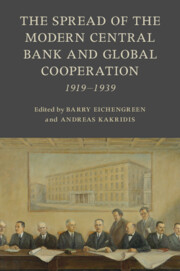Book contents
- The Spread of the Modern Central Bank and Global Cooperation
- Studies in Macroeconomic History
- The Spread of the Modern Central Bank and Global Cooperation
- Copyright page
- Contents
- Figures
- Tables
- Editors and Contributors
- Preface
- Part I General
- 1 Interwar Central Banks
- 2 The Ideology of Central Banking in the Interwar Years and Beyond
- 3 Habit Not Heredity
- 4 Institutionalizing Central Bank Cooperation
- Part II Specific
- Index
- References
2 - The Ideology of Central Banking in the Interwar Years and Beyond
from Part I - General
Published online by Cambridge University Press: 02 November 2023
- The Spread of the Modern Central Bank and Global Cooperation
- Studies in Macroeconomic History
- The Spread of the Modern Central Bank and Global Cooperation
- Copyright page
- Contents
- Figures
- Tables
- Editors and Contributors
- Preface
- Part I General
- 1 Interwar Central Banks
- 2 The Ideology of Central Banking in the Interwar Years and Beyond
- 3 Habit Not Heredity
- 4 Institutionalizing Central Bank Cooperation
- Part II Specific
- Index
- References
Summary
This chapter asks how a new generation of central banks in the interwar period changed their function, away from state financing and financial stability provision, and toward stabilizing prices and avoiding fiscal and financial dominance. The new concept of a central bank as an institutional constraint, imposed from the outside, and movement from a “can do” to a “can’t do” institution, ultimately ended in failure. It made for bad policy and poor outcomes, specifically contributing failure to stem contagion in the 1931 financial crisis. After 1945 a new reinvention of central banking involved the elaboration of a social consensus that bought back ele-ments of the “can do” environment.
Keywords
- Type
- Chapter
- Information
- The Spread of the Modern Central Bank and Global Cooperation1919–1939, pp. 40 - 56Publisher: Cambridge University PressPrint publication year: 2023
References
Primary Sources
Secondary Sources
- 2
- Cited by

